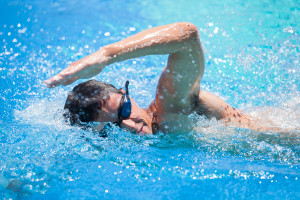 Patients with pulmonary arterial hypertension often have a difficult time finding an exercise routine that works for them. With restrictions to how much weight they can lift, body position (recommended to avoid bending with head below waist), and avoiding unnecessary sun exposure; exercise options seem very limited. Many patients also rely on awkward and sometimes heavy oxygen equipment limiting their options even more.
Patients with pulmonary arterial hypertension often have a difficult time finding an exercise routine that works for them. With restrictions to how much weight they can lift, body position (recommended to avoid bending with head below waist), and avoiding unnecessary sun exposure; exercise options seem very limited. Many patients also rely on awkward and sometimes heavy oxygen equipment limiting their options even more.
Swimming can be a great exercise for PAH patients. It doesn’t matter if you choose to swim laps, join a water aerobics class, or simply perform stretching exercises while in the water. There is an option for all fitness levels.
Many patients with pulmonary arterial hypertension are afraid to exercise but being fit is an important part of living a healthy life. Being in the water makes swimming easier to start than other routines. Your body has to support less weight which makes moving stiff joints and muscles that haven’t been worked in a while a lot easier. Just like with all activities each patient should listen to their body. They should take rest periods during their swim and start slow and gradually increase the time they spend working out.
5 Benefits of Swimming
- Improved Mood- Exercise releases hormones called endorphins. These feel good chemicals lead to a more positive outlook and improved mood.

- Less stress- Swimming can have the same relaxing effect as yoga, decreasing the amount of stress a person feels.
- Great cardiopulmonary work out- It is easier for patients with physical limitations to get moving in water and work out their heart and lungs.
- Builds muscle tone without lifting heavy weights- It is recommended that PAH patients avoid lifting anything that requires them to strain. Swimming is a great way to increase muscle tone by using the resistance of the water.
- Improved Sleep- Inactive patients often have difficulty with restlessness or sleeplessness. Swimming helps tire your muscles and relax your mind often leading to improved sleep.
Tips For Making Your New Swimming Routine Successful
 Off Hours- Avoid peak hours at the pool. By choosing less busy times you should be able to have your pick of lanes. Choose one next to the wall making it easier to take breaks whenever necessary.
Off Hours- Avoid peak hours at the pool. By choosing less busy times you should be able to have your pick of lanes. Choose one next to the wall making it easier to take breaks whenever necessary.- Use Oxygen- Yes you can swim with oxygen! If you require oxygen work with your oxygen equipment supplier to obtain long tubing typically used with an oxygen concentrator at home. Use the tubing with a portable tank for the pool. Choosing a slow time at the pool will help you avoid getting tangled up with anyone.
- Bring a Friend- It is always a good idea to try a new exercise with a friend. It is more fun and of course safer. Swimming alone in a pool without a lifeguard is not a good option.
- Remember Sun Safety- Most PAH medications increase a patient’s sensitivity to sun. Swim indoors or avoid swimming when the sun is directly over the pool. Use sunscreen when necessary.
